Overview of the General Steps for Handling Hinges
An overview of the four steps for handling hinges is show in Exhibit 8-2.
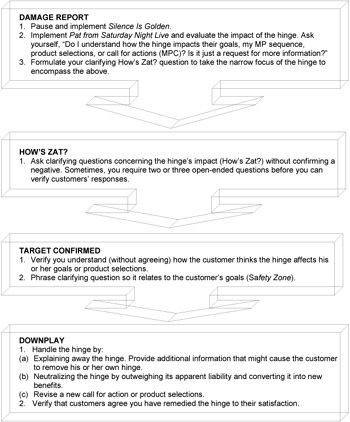
Exhibit 8-2: Overview of the four steps.
John Peters's sales call with Brian Walters now encounters unexpected twists and hinges. These examples demonstrate how to apply the strategies and tactics for handling hinges inside the Measurable Phases.
Review the following steps for active questioning to see how they are applied in the case study.
-
Follow the Customers' Lead. Relate all clarifying questions to customers' last responses on how their hinges affect their goals and filters.
-
Ask Specific but Open-Ended Questions. Do not use yes-or-no questions unless you need to verify a point.
-
No Loose Ends. Verify that a goal or filter is measurable before pursuing another.
-
Don't Shoot Yourself. Never confirm a negative statement.
-
Think Positively. Never make a negative assumption.
-
No Echoes. Rephrase the customers' responses; do not repeat them verbatim.
Type I: Pulse Check—No Interest in Any Goals in MP 1 (Leveraged)
John: Mr. Walters, we have helped some homeowners to reduce utility costs, sometimes by as much as one third, and other homeowners to increase hot water capacity by 50 percent. Are either of these areas of interest to you or are there any other ones more pertinent? (Uses spark interest statement to generate and verify interest.)
Brian: I am not interested at this time. (Disregards spark interest statement.)
(See Exhibit 8-3.)
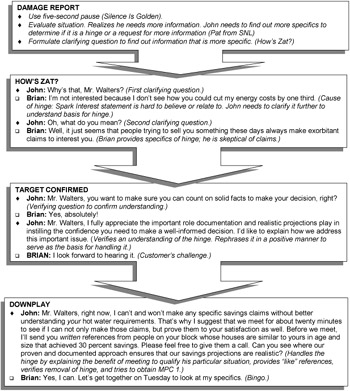
Exhibit 8-3: Pulse check scenario.
Type II: Iceberg Ahead—Unfavorable Filter Surfaces in MP 2 (Natural)
Brian: I don't want to exceed my budget. (A vague response that needs clarifying.)
John: Mr. Walters, what price range have you set? (Clarifying question.)
Brian: I really don't want to exceed $500. (An unfavorable filter—product lines start at $750.)
(See Exhibit 8-4.)
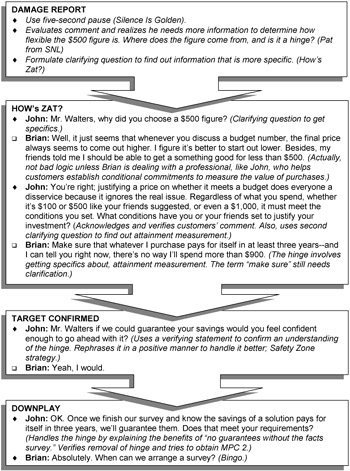
Exhibit 8-4: Iceberg ahead scenario.
Type III: Gutter Ball—Unfulfilled Commitment in MP 3 (Leveraged)
John: Brian, can you see how the XLX 9000 meets all your hotwater requirements of capacity and efficiency? In addition, it saves you more than $800 over the next three years and exceeds your payback schedule with its $750 price. It also includes a five-year warranty.
Brian: John, I don't see how the XLX 9000 meets all my requirements. (Unfulfilled conditional commitment.)
(See Exhibit 8-5.)
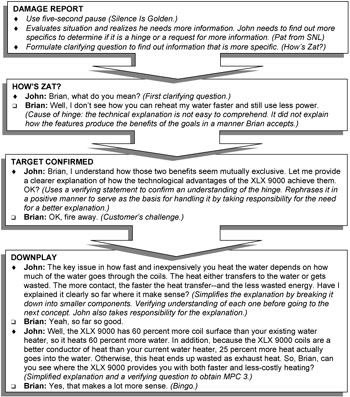
Exhibit 8-5: Gutter ball scenario.
Type IV: Rip-Off—Views Price as Excessive in MP 4 (Leveraged)
John: So, Brian, can you see how the XLX 9000 meets all your hot-water requirements of capacity and efficiency? In addition, it saves you more than $800 over the next three years and exceeds your payback schedule based on its price of $750. It also includes a five-year full warranty. (Rephrases to focus on the benefits, not the features. John also makes price what it should be—just another function of the requirements of the conditional commitment and not a stand-alone issue.)
Brian: Yes, I can see where it can benefit my situation, but the price is a lot higher than I thought it should be. (Perceives price as excessive.)
(See Exhibit 8-6.)
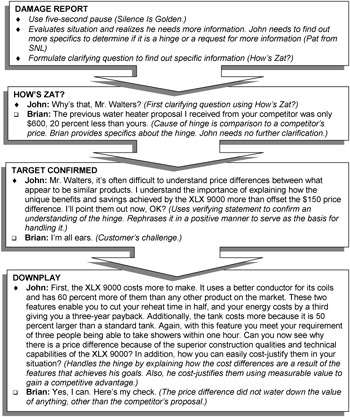
Exhibit 8-6: Rip-off scenario.
How to Handle Type I: Pulse Check
Exhibit 8-7 and Exhibit 8-8 demonstrate how to handle the pulse check hinge.
| Type I: Pulse Check | |
|---|---|
| Synopsis: This hinge occurs when customers show no interest in the broad array of goals, benefits, or potential rewards you described in MP 1: Spark Interest. It is the most difficult hinge to handle because it occurs so early. You do not have a lot of information to clarify to determine your next step. | |
| Category of Hinge: Leveraged | |
| Surfaces: MP 1: Spark Interest Re-enter Sale At : MP 1: Spark Interest | |
| Result: You cannot obtain MPC 1: Interest Confirmed. | |
| Causes: | Remedies: |
|
|
|
|
|
|
|
|
|
|
|
|
Exhibit 8-7: Type I— Pulse check.
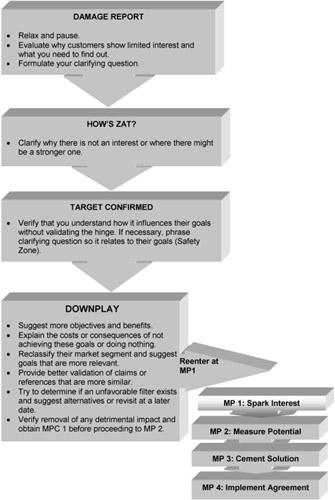
Exhibit 8-8: How to handle the pulse check hinge.
How to Handle Type II: Iceberg Ahead
Exhibit 8-9 and Exhibit 8-10 demonstrate how to handle the iceberg ahead hinge.
| Type II: Iceberg Ahead | |
|---|---|
| Synopsis: This hinge occurs when customers disclose goals, filters, or conditional commitments that impede their or your ability to achieve or satisfy them. In addition, this hinge occurs when price or delivery become customers' goals. | |
| Category of Hinge: Natural or Leveraged | |
| Surfaces: Usually occurs in MP 2: Measure Potential as a natural hinge. It also arises in MP 3: Cement Solution as a leveraged hinge. Anytime a hinge is leveraged, it is much more difficult to handle. Reenter Sale at: MP 2: Measure Potential or MP 3: Cement Solution | |
| Result: Salesperson cannot obtain MPC 2: Potential Confirmed | |
| Causes: | Remedies: |
|
|
|
|
|
|
|
|
|
|
|
|
Exhibit 8-9: Type II— Iceberg ahead.
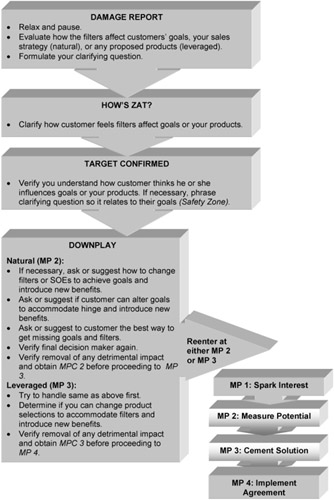
Exhibit 8-10: How to handle the iceberg ahead hinge.
How to Handle Type III: Gutter Ball
Exhibit 8-11 and Exhibit 8-12 demonstrate how to handle the gutter ball hinge.
| Type III: Gutter Ball | |
|---|---|
| Synopsis: This hinge occurs when customers perceive your products as not fulfilling their goals, measurable benefits, or conditional commitments. | |
| Category of Hinge: Leveraged | |
| Surfaces: MP 3: Cement Solution Reenter Sale at: MP 3: Cement Solution | |
| Result: You cannot obtain MPC 3: Solution Confirmed. | |
| Causes: | Remedies: |
|
|
|
|
|
|
Exhibit 8-11: Type III— Gutter ball.

Exhibit 8-12: How to handle the gutter ball hinge.
How to Handle Type IV: Rip-Off
Exhibit 8-13 and Exhibit 8-14 demonstrate how to handle the ripoff hinge.
| Type IV: Rip-Off | |
|---|---|
| Synopsis: This hinge occurs when you disclose the price of your products. Customers consider your price excessive although it meets their conditional commitments. Three factors influence what customers expect the price level to be: (1) What they guess it costs to manufacture the product or provide the service multiplied by a reasonable markup. (2) The total value of the perceived and measurable benefits. (3) The price levels of what customers consider similar products. | |
| Category of Hinge: Leveraged | |
| Surfaces: MP 4: Implement Agreement Reenter Sale at: MP 3: Cement Solution or MP 4: Implement Agreement | |
| Result: Salesperson cannot obtain MPC 4: Agreement Confirmed | |
| Causes: | Remedies: |
|
|
|
|
|
|
Exhibit 8-13: Type IV— Rip-off.

Exhibit 8-14: How to handle the rip-off hinge.
EAN: 2147483647
Pages: 170